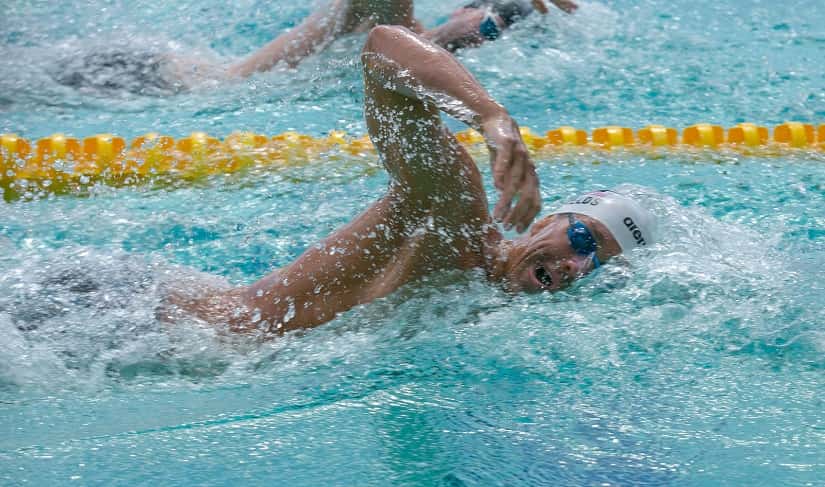A more balanced stroke will help you swim faster and more efficiently. Here’s why an even stroke is so critical, and what you can do to balance it out.
Strong sides are an inevitable part of our swimming.
Nearly all of us are naturally dominant on one side out of the water, so it makes sense that we would carry this into the pool with us.
But when we allow it to dominate our swimming, it opens the door to some problems and missed opportunities.
Why does a balanced stroke matter?
- You’ll be a faster swimmer. What’s better than having one strong side? Two strong sides. A balanced stroke helps pull you at a consistent pace through the water, instead of the stop-and-go that is common with strong side strokes.
- You’ll reduce the likelihood of injury. One of the leading causes of swimmer’s shoulder is muscle imbalance.
- You’ll be technically more proficient. An uneven stroke can often mean that our technique is different from one side of our body to the next. A balanced stroke will help you be more efficient in the water.
Here are a few different ways that you can work on getting more balance in your stroke.
Swim with a snorkel.
One of the best tools for competitive swimmers is the swim snorkel. It allows you to keep your face down in the water so that you can focus on the rhythm and range of proper technique.
In particular, it will help you develop a more balanced stroke for you freestylers.
Because you don’t need to worry about breathing, and the body change that occurs when we breathe isn’t present, the hitch or gallop in our stroke disappears.
Breathe bilaterally.
Breathing patterns are an individual thing, and the breathing patterns you hold during the longer aerobic and drill parts of your workout won’t be the same as what you do in competition.
For example, a typical 100m freestyler will breathe every 2 strokes for most of their race. This doesn’t mean they should exclusively breathe this way during their swim practices.
During the main sets you should breathe the same way you would in competition, but the rest of the time you should be working on developing a fuller, more balanced stroke by breathing bilaterally, especially during the lower intensity work.
There are a few different ways you can do this as well:
- Breathe every three strokes. Super simple.
- Breathe to the same side of the pool. On the up the pool you breathe to the right, on the way back to the left. In both cases you are facing the same side of the pool. Michael Phelps made a point of doing this in training.
- Alternate bilateral breathing with every two stroke breathing. One of my favorite breathing patterns, especially during warm-up when my inspiratory muscles aren’t warmed up yet, is to keep a breathing pattern alternating 2 and 3 breaths. This way I am getting lots of oxygen until my lungs adapt, and also getting both sides an equal amount of attention.
Anti-rotation core work.
One of my favorite core exercises for swimmers is the Russian twist. It does a great job in simulating the shoulder rotation and stable hip placement that is required for fast freestyle swimming.
A common problem that happens when we breathe to our non-dominant side is that we corkscrew our hips. You know this moment well—your ankles hit each other, your hand entry likely crosses center, and suddenly the propulsion and body position we had crumbles.
The benefits of core work for swimmers goes beyond having a sexy set of abdominal muscles—a strong core helps you maintain a steady balance in the water
Kick without a board on your non-dominant side.
Learning balance in the water is one of the first things we learn when we are kids. We figure out how to position our body so that we float with as little effort as possible.
This kind of balance work isn’t just for the newbies in the toddler pool—the applications of better balance very well work for age group and national level swimmers too.
For swimmers who have a particular attachment to breathing one side, one of the things I notice when they breathe to their off side is the hips dropping (or rather, sinking).
It’s like the moment they breathe to their weak side they’ve lost the ability to properly position themselves across the surface of the water.
Kicking without a board, with one arm above your head, will help teach you that innocent little lesson we all learned when we were just starting out—how to position our body properly in the water.
Use a parachute
One of my favorite tools for faster swimming in the water, whether I am trying to level up my freestyle kick or improve my freestyle technique, is using a swim parachute.
Although the tool is generally used for power development purposes, try swimming with a parachute that has light resistance to help you get into the flow of what your stroke pattern should feel like. The added resistance will emphasize the dips in momentum within your stroke.
Try doing 25s and 50s with a parachute with plentiful rest and work on trying to get the most of your stroke.
More Stuff Like This:
7 Drills for a Faster Freestyle. Olympic coaches and swimmers including Mike Bottom and Auburn’s Brett Hawke stop by to share some of their favorite freestyle drills.
How to Prevent Swimmer’s Shoulder. All too common with swimmers is the dreaded swimmer’s shoulder. Here’s your guide to avoid it once and for all.
How to Develop an Unstoppable Freestyle Kick. Great swimmers are great kickers. Put yourself on the path to kicking like a beast with this overview of building powerful legs.














